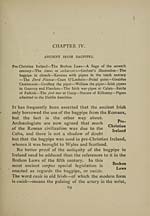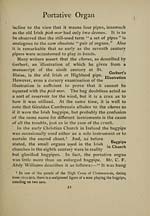Inglis Collection of printed music > Printed text > Story of the bagpipe
(46) Page 20
Download files
Complete book:
Individual page:
Thumbnail gallery: Grid view | List view

Story of the Bagpipe
but primarily the vein, a blood-vessel, hence a pipe.
At the great Feis (Assembly, or Parliament) of Tara
the pipers occupied a prominent position, as we read
that the cuisleannach, or pipes, were among the
favourite instruments heard in the banqueting hall
{teach miodhchuarta). 1 This Feis was held from pre-
Christian days until the year 560, when King Dermot
MacFergus presided over the last Feis, after which date
" Tara's Halls" were for ever deserted.
In one of the ancient Irish historical tales, dating
from the seventh century, and which describes the
Bruidhaen da Derga, a palace of Da Dersr,
aga o t c a j. ]3 tj mr na Brnighne (Bohernabreena),
Seventh ^ ~ ... , . .
„ County Dublin, there is given an account
Century J ' & ,
01 the persons who came to pay homage to
King Conaire the Great, B.C. 35. Among others were
"nine pipers from the fairy hills of Bregia" (County
Meath). These pipers are described as " the best pipe-
players in the whole world," and their names are given
as Bind, Robind, Riarbind, Sihe, Dibe, Deichrind,
Umal, Cumal, and Ciallglind.
In this old saga' J the bagpipes, or " set of pipes," is
called tinnc, whilst the band of pipers is designated
cetharcoire, or the four-tuned. Whitley
_ , , Stokes is of opinion that cetharcoire has
Letharcoire r , . . ± , , ..
reference to the tuning or the chanter, the
long drone, and the two reed-drones; but I rather
1 Petrie's Antiquities of I lie Hill of Tara.
2 In the Fair of Carman, dating from the seventh century, allusion
is made to pipers and fiddlers.
20
but primarily the vein, a blood-vessel, hence a pipe.
At the great Feis (Assembly, or Parliament) of Tara
the pipers occupied a prominent position, as we read
that the cuisleannach, or pipes, were among the
favourite instruments heard in the banqueting hall
{teach miodhchuarta). 1 This Feis was held from pre-
Christian days until the year 560, when King Dermot
MacFergus presided over the last Feis, after which date
" Tara's Halls" were for ever deserted.
In one of the ancient Irish historical tales, dating
from the seventh century, and which describes the
Bruidhaen da Derga, a palace of Da Dersr,
aga o t c a j. ]3 tj mr na Brnighne (Bohernabreena),
Seventh ^ ~ ... , . .
„ County Dublin, there is given an account
Century J ' & ,
01 the persons who came to pay homage to
King Conaire the Great, B.C. 35. Among others were
"nine pipers from the fairy hills of Bregia" (County
Meath). These pipers are described as " the best pipe-
players in the whole world," and their names are given
as Bind, Robind, Riarbind, Sihe, Dibe, Deichrind,
Umal, Cumal, and Ciallglind.
In this old saga' J the bagpipes, or " set of pipes," is
called tinnc, whilst the band of pipers is designated
cetharcoire, or the four-tuned. Whitley
_ , , Stokes is of opinion that cetharcoire has
Letharcoire r , . . ± , , ..
reference to the tuning or the chanter, the
long drone, and the two reed-drones; but I rather
1 Petrie's Antiquities of I lie Hill of Tara.
2 In the Fair of Carman, dating from the seventh century, allusion
is made to pipers and fiddlers.
20
Set display mode to: Large image | Transcription
Images and transcriptions on this page, including medium image downloads, may be used under the Creative Commons Attribution 4.0 International Licence unless otherwise stated. ![]()
| Special collections of printed music > Inglis Collection of printed music > Printed text > Story of the bagpipe > (46) Page 20 |
|---|
| Permanent URL | https://digital.nls.uk/94509728 |
|---|
| Description | Scottish and English songs, military music and keyboard music of the 18th and 19th centuries. These items are from the collection of Alexander Wood Inglis of Glencorse (1854 to 1929). Also includes a few manuscripts, some treatises and other books on the subject. |
|---|
| Description | The Glen Collection and the Inglis Collection represent mainly 18th and 19th century Scottish music, including Scottish songs. The collections of Berlioz and Verdi collected by bibliographer Cecil Hopkinson contain contemporary and later editions of the works of the two composers Berlioz and Verdi. |
|---|

